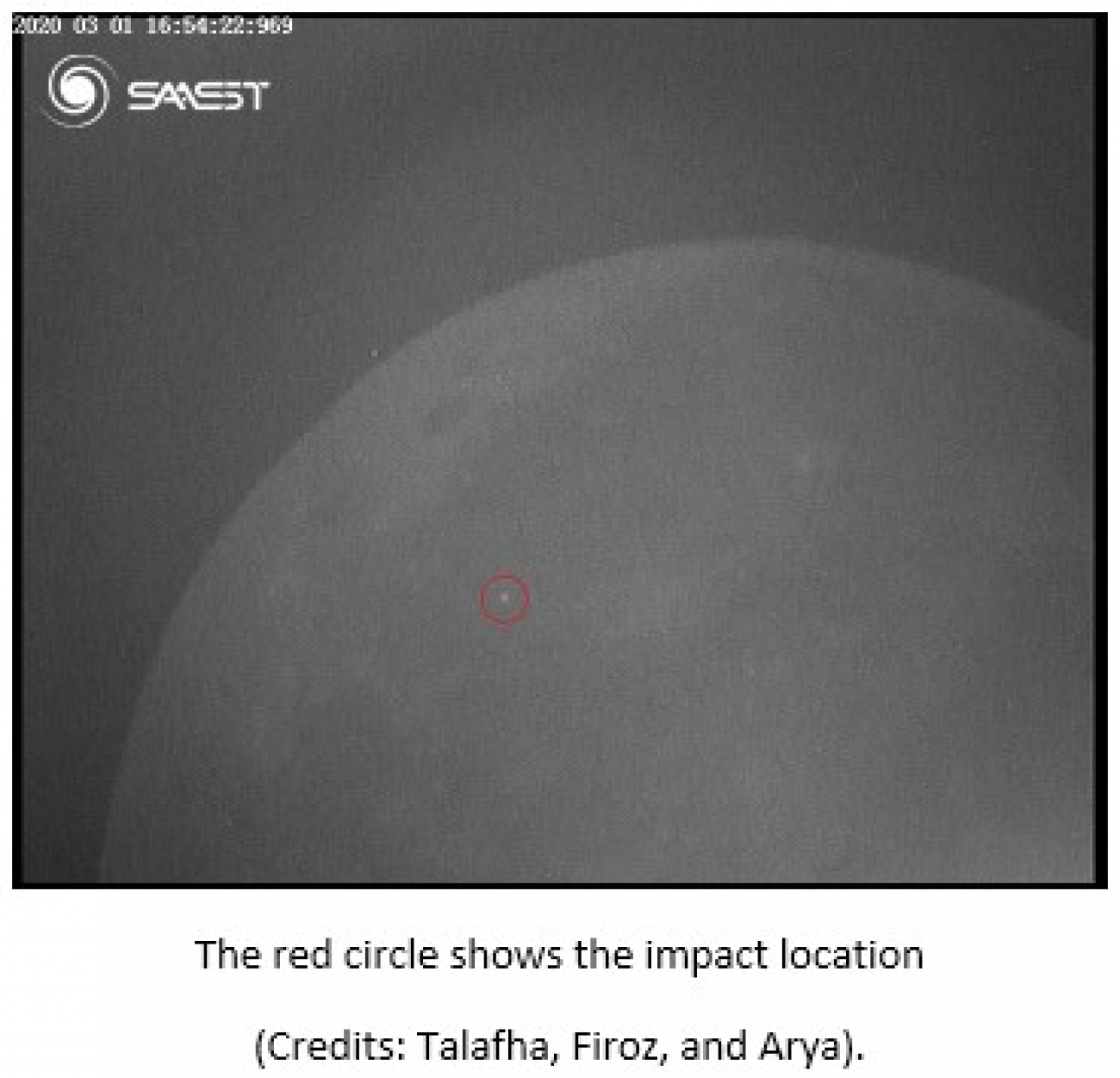This new observation unit provides a great opportunity to monitor the new events that occur in the solar system. This event was monitored on Sunday March 1st, 2020 at 20:54:23, with a duration of about 0.04 sec (the airmass was about 1.53). The preliminary results gave the lunar impact flash a magnitude of about 8.3, and on the lunar longitude - 45.1 degrees and lunar latitude -7.8.. More calculations about the physical parameters of the impactor, i.e., the energy emitted, the mass of the meteoroid, size of the crater created on the Moon surface, are still underway. Mr. Mohammed Fadil Talafha, Research Assistant and Observer at SAASST, carried out the observation process with two students from the University of Sharjah: Firoz Abdul Aziz Chogle and Arya Pratap Rajawat. SAASST includes students in a number of its research projects with the aim of delivering scientific information in an applied manner and raising their awareness of the importance of the astronomy and space sciences field as well as the latest developments in the UAE space sector. This in line with the vision of His Highness Sheikh Dr. Sultan bin Muhammad Al Qasimi, Member of the Supreme Council, Ruler of Sharjah and President of the University of Sharjah, who founded the Sharjah Academy for Astronomy, Space Sciences and Technology as a national development project and research center that seeks to serve and educate society in all areas of space science and to be a world leader in space sciences and technology research while establishing the United Arab Emirates as a scientific center in the Arab Gulf region and the world.
SAASST recently installed within the project of the Sharjah Lunar Impact Observatory (SLIO) a new 3-meter dome equipped with a 14-inch Meade telescope along with several sensitive instruments. This project is important as it performs ground-monitoring of the dark part of the moon to determine the rates and sizes of large meteorites ( above 10 grams) hitting the surface of the Moon. This new observatory is specialized in monitoring meteorite collisions on the Moon’s surface with the aim of enhancing understanding of their effects on space missions, which in turn helps to protect and facilitate manned spaceflights. By monitoring such phenomena, we open the way to study the types and effects of such impacts on the Moon’s surface and how they form Lunar craters over billions of years. The Observatory's team is persistent and committed to observing and monitoring this type of events and sharing its results with other observatories around the world.
Along with installing the new SLIO, and thanks to the continuous support of His Highness the Ruler of Sharjah, and the effective involvement of His Excellency Prof. Hamid M.K. Al Naimiy, Chancellor of the University of Sharjah, SAASST is home to a number of laboratories, including: CubeSat Laboratory, Radio Astronomy Laboratory, Meteorite Center, Space Weather and Ionosphere Laboratory, High Energy Astrophysics Laboratory, and the Sharjah Optical Observatory. The Academy is unique in the Gulf Region, and during the last two years, the it also published over 30 papers in international scientific journals and is expecting more accomplishments using the new 40-meters radio interferometer and the SLIO. The Academy also focuses on organizing a number of events with the aim of spreading awareness of the importance of the space sector and scientific astronomical culture, and the development of qualified national cadres in this field within a highly astronomy and space sciences aware and knowledgeable society.
It is also worth noting that the SLIO detection on March 1st, 2020 of the lunar impact flash observed for the first time from the MENA region confirmed the 100th detection by the NELIOTA project by the European Space Agency (ESA). This is a great global scientific accomplishment by the new SLIO project, which is already making contributions to the international astronomy and space sector. NELIOTA is an activity launched by the European Space Agency (ESA) at the National Observatory of Athens (NOA) in February, 2015. It aims to determine the distribution and frequency of small NEOs (Near-Earth Objects) by monitoring lunar impact flashes.
You can read more on this contribution at:
https://www.esa.int/Safety_Security/100th_lunar_asteroid_collision_confirmed_by_second_telescope
You can also learn more about NELIOTA at:
https://www.esa.int/Safety_Security/Learning_from_lunar_lights



